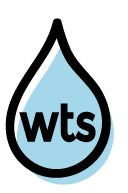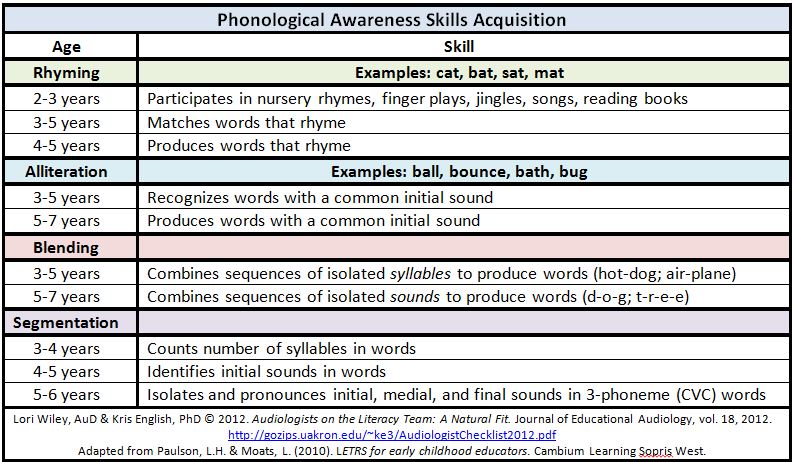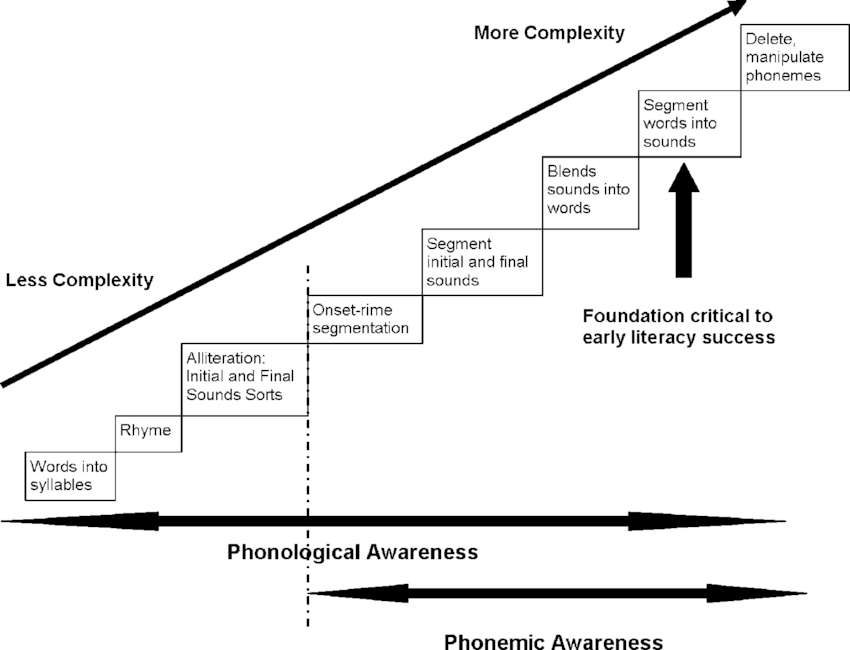Have you ever wondered what you can do at home to help your child learn how to read? This series of posts will assist you with teaching your child early literacy skills.
In my last post, I discussed rhyming, which is an early part of phonological awareness. When you target phonological awareness, you are laying the foundation for literacy.
Phonological awareness probably sounds like a lot to tackle! But don’t despair! By playing word games with your child you can turn learning into a fun and desirable activity, allowing you to relax while educating your child. It’s a win-win situation!
Speaking of word games, be sure to check out this Halloween themed game:
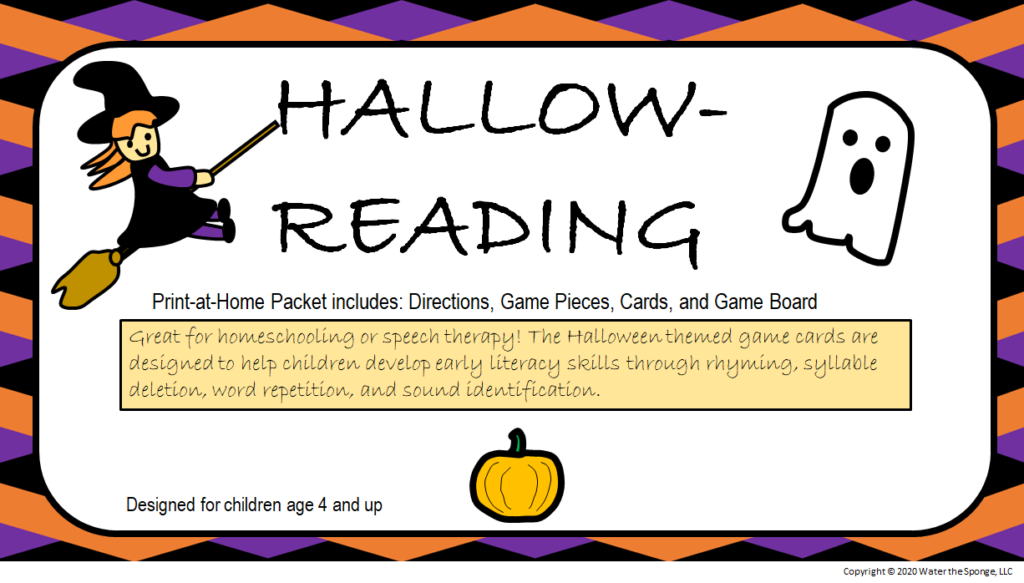
I encourage you to purchase the game above to improve your little one’s early literacy skills! The target age range is 4 years and older.
Okay, back to the topic at hand. Before we get into syllable deletion, let’s cover phonological awareness (PA) first. I think that by knowing the components of PA, we can start to understand how these influence reading skills.
If you’d prefer to jump to the end and see tips for syllable deletion, be my guest!
What is Phonological Awareness?
Essentially, phonological awareness is the ability to hear, understand, and manipulate sounds within words, be it at the syllable level or phonemic (single sound) level. Some examples of tasks involved in phonological awareness include rhyming, alliteration, identifying the number of syllables in a word, identifying sounds in a word, and blending syllables or sounds to produce words.
The image below tells you about the components of phonological awareness and gives age ranges as to when each skill should be acquired.
You can see that there are several different categories and subcategories that exist within PA and that these are introduced and mastered between 3 and 7 years of age.
Here is a graphical representation which might be useful:
As you can see from the graph, each phase of phonological awareness builds upon itself. Having the ability to divide words into syllables and rhyme words fall on the earlier side of the spectrum. While syllable deletion does not appear on the graph, it falls on the phonological awareness side of the spectrum.
I could write an entire post, or fifty, dedicated to phonological awareness, but this gives you the gist of what it is. If you have specific questions around this chart, please feel free to leave a question at the end of the post!
What is Syllable Deletion?
What do I mean when I say “syllable deletion”? When it comes to words, they are naturally broken into syllables. In order to be considered a syllable, the component MUST contain a vowel sound.
When I refer to syllable deletion, I’m referring to removing parts of a multisyllabic word. In order to complete this task, a child would first have to be able to identify the syllabic components of a word first.
Compound words, or single words that are made up of multiple words, are the easiest types of words to start with when it comes to syllable deletion. Examples: “Hotdog” without “hot“, is “dog“. “Baseball” without “ball” is “base”.
Kids might find regular words a little trickier, but the same concept applies. For instance, the word “dresser” without “er” is “dress”. When your kiddo is a pro, then you can try removing middle syllables to see if your child can still manipulate the word accordingly. The word “trampoline” without “po” is “tramline”.
A lot of kids get a kick out of how silly words sound when they’re missing pieces. Relax and have some fun with this task!


When to Introduce Syllable Deletion?
The earlier the better, but according to Reading Rockets, this particular skill is typically mastered around age 6. (See their data here.)
As previously stated, this skill would be pretty difficult to master before a child can even identify syllables. So, start with syllable identification first before you work your way up to syllable deletion.
You can start planting the seed as early as you’d like! I work with my 3-year-old on identifying syllables because he seems to enjoy playing around with words. I haven’t introduced the concept of syllable deletion to him just yet, but I will when he seems ready and interested. If you’ve read previous posts, then you’ll know how much I love using the strategy of “tapping-it-out” to identify syllables and I do that often with my 18-month-old!
Why is Syllable Deletion Important?
The primary reason, as I’ve mentioned previously, is that it builds phonological awareness. In turn, this leads to improved early literacy AND language development.
There is ample research that demonstrates phonological awareness is directly linked to early literacy. This position statement released in 2019 from the International Literacy Association summarizes the research well.
The International Literacy Association maintains that phonological awareness has a critical role in early literacy and language development. Purposeful, efficient, and developmentally appropriate instruction in phonological awareness can support young children’s literacy and language development and help them understand how to decode and spell words, particularly when combined with instruction in both alphabet and vocabulary knowledge.
CITATION
In addition, manipulating syllables tests the brain’s ability to use working memory. Can your child remember all of the syllables involved in the word, remove one of them, then create the new word? When thinking about the different steps involved in this manner, you come to realize that there is a lot that goes into syllable deletion.
Now that we know why syllable deletion is important, let’s get to the fun part!
Let’s Water the Sponge!
Remember to take a look at this game and purchase it if you think your little one would enjoy it:



The target age range is 4 years and older and it will improve your little one’s early literacy skills!
Here are some tips and tricks for things you can do at home to improve your child’s ability to delete syllables.
Visual Tactic
If your child is really struggling with syllable identification and manipulation, try using colorful blocks as a visual and tactile representation for syllables. Kids learn in different ways and this technique will appeal to children’s tactile and visual centers!
You can purchase these off of Amazon for a reasonable price and use them for other educational purposes as well! (I just used some blocks from Melissa & Doug’s Primary Lacing Beads.)
A quick example – let’s say the word is “bicycle”, the word contains three syllables, so you would use three different colored blocks to represent the syllables. If you remove the first syllable, “bi”, then you would also remove the corresponding first block from the string of three.
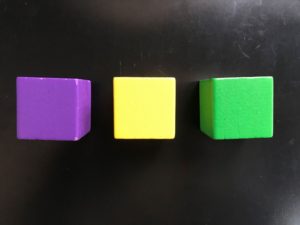

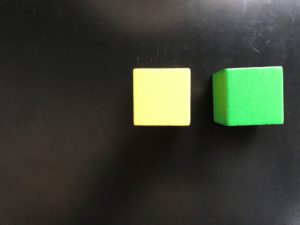

Compound Word List – Real Words (2+ syllables)
| Say the Word | Remove the Syllable(s) | Answer |
|---|---|---|
| Raincoat | rain | coat |
| Starfish | star | fish |
| Pancake | pan | cake |
| Earring | ear | ring |
| Snowman | snow | man |
| Catfish | fish | cat |
| Rainbow | bow | rain |
| Lighthouse | house | light |
| Butterfly | fly | butter |
| Watermelon | melon | water |
Mutisyllabic Word List – Real Words (2+ syllables)
| Say the Word | Remove the Syllable | Answer |
|---|---|---|
| Eating | eat | ing |
| Bicycle | bi | cycle |
| Hamster | ham | ster |
| Garden | gar | den |
| Branches | branch | es |
| Telephone | phone | tele |
| Circle | cle | cir |
| Yellow | low | yel |
| Tomato | to | toma |
| Duckling | ling | duck |
Multisyllabic Word List – Nonsense Words (2+ syllables)
| Say the Word | Remove this Syllable | Answer |
|---|---|---|
| Goobdah | goob | dah |
| Apnikel | ap | nikel |
| Plavinsion | pla | vinsion |
| Octomug | oc | tomug |
| Wynomiz | wy | nomiz |
| Timnov | nov | tim |
| Lishnip | nip | lish |
| Flimpernub | nub | flimper |
| Schimzing | zing | schim |
| Baflijig | jig | bafli |
Check out these word lists above! You can pair these with turn-taking games. Have the child say the word (repeat after you), then say it again without the syllable in the second column. Answers are provided for your convenience in the third column. You can do this with real words, nonsense (made-up) words, or mix-and-match!
Closing thoughts
Phew – I know this was a dense post! Please leave any questions you might have below and I’d love to answer them! Have any stories about success you’ve had at home with learning how to delete syllables? Let me know below!
